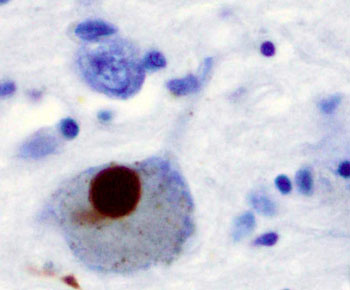Toxic Clumps of Alpha-Synuclein Disrupt Function in Parkinson's Disease Neurons
By LabMedica International staff writers
Posted on 21 Jun 2016
Neurodegenerative disease researchers have found that some symptoms of Parkinson's disease (PD) are caused by the deleterious effect of toxic clumps of alpha-synuclein on mitochondrial function.Posted on 21 Jun 2016
The accumulation of misfolded alpha-synuclein amyloid fibrils leads to the formation of insoluble aggregates that have been implicated in several neurodegenerative diseases, including Parkinson's disease, dementia with Lewy bodies, and Alzheimer's disease. It has been exceedingly difficult to define the structure of alpha-synuclein fibrils due to their insolubility and complexity.

Image: Positive alpha-synuclein staining of a Lewy body from a patient who had Parkinson\'s disease (Photo courtesy of Wikimedia Commons).
Alpha-synuclein accumulation and mitochondrial dysfunction have both been strongly implicated in the pathogenesis of PD, and the two appear to be related. Mitochondrial dysfunction leads to accumulation and oligomerization of alpha-synuclein, and increased levels of alpha-synuclein cause mitochondrial impairment, but the basis for this bidirectional interaction remains obscure.
Investigators at the University of Pittsburgh School of Medicine (PA, USA) worked with a well-established rodent model of PD to show how alpha-synuclein disrupted mitochondrial function. They reported in the June 8, 2016, online edition of the journal Science Translational Medicine that specific forms of wild-type alpha-synuclein, such as oligomeric and dopamine-modified forms, but not the monomeric or fibrillar forms, bound with high affinity to the mitochondrial receptor TOM20 (Mitochondrial import receptor subunit TOM20 homolog).
This binding disrupted import of proteins required for mitochondrial function and led to senescence of mitochondria, which showed reduced respiration and increased production of reactive oxygen species.
Examination of postmortem brain tissue from PD patients revealed an aberrant alpha-synuclein–TOM20 interaction in nigrostriatal dopaminergic neurons that was associated with loss of imported mitochondrial proteins, thereby confirming this pathogenic process in the human disease.
"It is really exciting that we have found a mechanism we can target to create new treatments for this devastating disease," said senior author Dr. J. Timothy Greenamyre, professor of neurology at the University of Pittsburgh School of Medicine. "Ultimately, the interaction between alpha-synuclein and TOM20 leads to neurodegeneration. The effects of alpha-synuclein on mitochondria are like making a perfectly good coal-fueled power plant extremely inefficient, so it not only fails to make enough electricity, but also creates too much toxic pollution."
Related Links:
University of Pittsburgh School of Medicine













